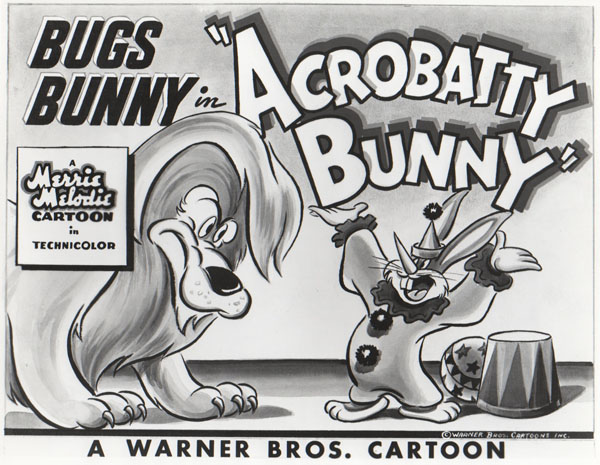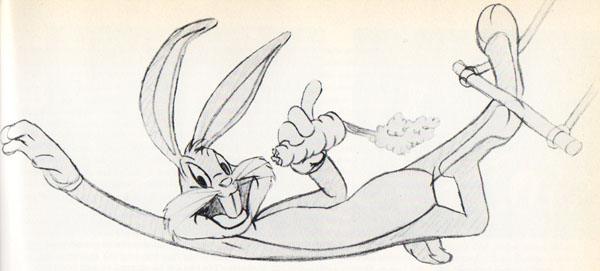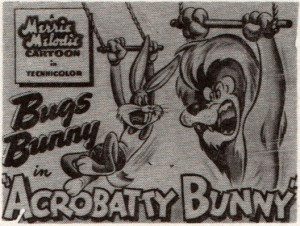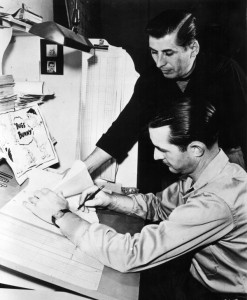
This week’s breakdown profiles one of my absolute favorite Bugs Bunny cartoons! (Editor’s Note: and mine too! – JB)
Bob McKimson’s first cartoon with Bugs preserved the loose, boisterous animation from Bob Clampett’s embodiment of the character. McKimson’s animators offered their strong, individualistic attributes early on. This kinetic energy would later be suppressed by their director’s supervision by the late ’48 releases.
Though not as innovative as the other Warner directors, McKimson’s directorial body during the ’40s had a raffish liveliness built on broad movement and violence. Story-man Warren Foster’s impudent dialogue also influenced their vivid mood. The echoing jab at Disney’s Pinocchio, as Bugs peers down into Nero the lion’s mouth, and his impatient response to have Nero join in his clownish act (“C’mon – LAUGH!”) imparts Foster’s vigor in McKimson’s cartoons.
Former New Yorker Foster was in the music business before his animation career. He played piano on a local radio station and owned a Broadway musical school that eventually folded. He worked at the Fleischer studio as an opaquer by October 1935, and later moved to the story department. Fleischer Animated News confirms Foster contributed writing on two Popeye cartoons – The Spinach Roadster (1936) and Protek the Weakerist (1937).
He moved to the West Coast to work for Warners in the Ray Katz unit, writing stories for Bob Clampett’s B&W Looney Tunes. Warren switched to Tashlin’s unit by April 1943 – though, his first credit for Tashlin, Puss n’ Booty, had a finalized story by February — and reunited with Clampett after Tashlin left.
According to an insightful interview from story-man Lloyd Turner, Foster was protective about his story sketches. He drew the paper onto a Life magazine and would close it when company arrived in his office. Turner recalled that Warren was less reticent in the story meetings, and would shift into his native Brooklynese accent when he presented a storyboard. He moved to Friz Freleng’s unit in the spring of 1949. Animator Phil Monroe stated that McKimson later felt resentment towards the decision. Foster stayed with Freleng until he left the studio in the late ‘50s for a job at the John Sutherland studio, and soon joined writer Mike Maltese at Hanna-Barbera, often reprising his stories/gags from Warners.

pencil art from the title card of “Acrobatty Bunny”
Don Williams is uncredited for his animation in Acrobatty Bunny. He tended to draw his characters more stocky and relied on dry brush for rapid action, though the latter isn’t utilized extensively in this cartoon. Williams draws Bugs’ face with an impish quality that appears almost rodent-like. A former animator for Walter Lantz in the early 30s, Williams was offered a job by Ray Katz offered at Schlesinger’s in 1933. He animated there until he left for a brief stint at Disney that lasted from August 1936 to February 1938. After Disney, he moved to MGM before coming back for Lantz, animating for Shamus Culhane and Dick Lundy. He went back to Warners until the late 40s, and his career took a standstill until he continued on to work at Hanna/Barbera and DePatie-Freleng.
Art Davis was already in the director’s chair by the time this was released. Davis’ stylized posing/timing as an animator shines in this cartoon, including the wonderful “Laugh Clown Laugh” sequence. Around 1920, as a teenager, his brother Mannie –later a director at Van Beuren and Terrytoons – got him a job as an errand boy at the Jefferson Film Corporation, which produced Mutt and Jeff cartoons. He also had the task of erasing animators’ pencil lines from the paper frames since those animated films hadn’t used cels.
 He assisted Dick Huemer at Max Fleischer’s studio at around 1924. He became the first artist specifically assigned as an in-betweener, as he drew and inked the drawings between Huemer’s key drawings. Davis also moved the “bouncing ball” – a cut-out white circle on a black stick – for the early Song Car-Tunes. Disney offered Davis, who was friends with Norm Ferguson, a job at his studio in the early thirties, but nothing prevailed.
He assisted Dick Huemer at Max Fleischer’s studio at around 1924. He became the first artist specifically assigned as an in-betweener, as he drew and inked the drawings between Huemer’s key drawings. Davis also moved the “bouncing ball” – a cut-out white circle on a black stick – for the early Song Car-Tunes. Disney offered Davis, who was friends with Norm Ferguson, a job at his studio in the early thirties, but nothing prevailed.
Later, he became an animator at the Mintz studio, where, with Huemer and Sid Marcus, he contributed to the development of Toby the Pup and Scrappy. Davis was promoted to director and helmed many cartoons, including the Oscar-nominated Little Match Girl (1937). He remained at the studio until October 1941 when Tashlin took over. He spent the next twenty years at Warners, first animating for Tashlin and McKimson, and finally, Freleng’s unit after his directorial unit dissolved in the late forties.
Cal Dalton’s drawing/animation in Acrobatty is considerably mushy, and isn’t as strong as his fellow animators. However, his scene of the panicky elephant using Nero to swat the toy mouse is hysterical. Dalton studied at Pasadena Junior College and soon joined the transient Romer Grey studio. He moved to Ted Esbaugh’s studio, animating on his early color cartoons, including the 1933 Wizard of Oz. That same year, he joined the Schlesinger studio, animating mostly in Freleng’s unit. Following Friz’s departure to MGM in 1937, Dalton took over his unit, where he collaborated with storyman Cal Howard to direct three cartoons (Porky’s Phoney Express, Katnip Kollege and A-Lad-In-Bagdad), and then teamed with Ben Hardaway.
It is unclear why Dalton didn’t serve as a sole director. Since Howard and Hardaway were writers, it’s likely that Dalton was in charge of timing and layout drawings. When Freleng returned to the studio in April 1939, their directorial stint subsided. Hardaway left for Lantz and Dalton went back to animating. After Warners, he worked on promotional films for John Sutherland in the ’50s and animated on the KFS Popeyes for Paramount in the early ’60s.
Dick Bickenbach’s work here has more of a Freleng essence, but the drawing/animation of his scene with Bugs’ first meeting with Nero is marvelous. Ub Iwerks looked over the Chouinard-schooled Bickenbach’s portfolio and hired him on the spot at his studio. When Iwerks’ studio closed, he animated for Lantz in three credited entries, released 1936-37. Bickenbach then moved to Warners, where he started with the Hardaway/Dalton unit and moved to Freleng’s upon his return. He animated on Tashlin’s last few Warners cartoons, and shifted to McKimson’s unit after Tashlin’s departure.Acrobatty is one of Bickenbach’s last cartoons for Warners before he migrated to MGM at the Hanna-Barbera unit. He stayed there for most of his career and claimed to have spent the last two days at MGM animating titles for their new television series, Ruff and Reddy before the cartoon division closed. Bickenbach is recognized for his appealing draftsmanship, and drew model sheets, layouts and coloring books of the H-B characters.
The unsung “Tolly” Kirsanoff shows up in this cartoon. He isn’t given many scenes, but the loose animation of the roustabouts hammering the stake, to the beat of Johnny Mercer/Richard Whiting’s “Sing You Son of a Gun,” is well executed. Kirsanoff moved to UPA by 1948 as an animator, but as with Warners, he was given no credit for his work. Kirsanoff moved into television, working with Larry Harmon on the animated Bozo the Clown television series. He animated for Hanna-Barbera, and then Filmation, where he became a sequence director by the late ’60s. Mark Kausler, then an inbetweener, shared that Tolly “was constantly being paged on the intercom by Hal Sutherland and Norm Prescott [two of the producers]. He ducked into our inbetween room once or twice and just said he was hiding out for a minute.”
The draft for Acrobatty still bears the name “Leon Schlesinger Productions,” though Schlesinger sold the studio to Warner Bros in July 1944, and McKimson took over Tashlin’s unit by September that same year. At present, it’s unclear when this started production. Scene 6A of Bugs waking up to the noise outside, and the cartoon’s final close-up, have no credit on the document, but there are names attributed on the video, based on their distinctions in drawing/movement.
I’d say this is a perfect entry for the start of the summer. Hope you all enjoy Bugs at the big top!


(Thanks to Michael Barrier, Bob Jacques, and Dave Smith for their help.)



 DEVON BAXTER is a film restoration artist, video editor, and animation researcher/writer currently residing in Pennsylvania. He also hosts a
DEVON BAXTER is a film restoration artist, video editor, and animation researcher/writer currently residing in Pennsylvania. He also hosts a 





















































































Another excellent post Devon! Always glad to see more of the the early McKimson cartoons; McKimson couldn’t control these animators (probably because they didn’t follow his layouts exactly), so seeing (and knowing the location of) Davis and Williams animation is always a treat.
Lot of fun surprises in this one; looks like Tolly mostly did the transitional shots.
The closing music has a more quiet section, as if Porky or Bugs would say their line. Also, as the company name is printed on the sheets, I would assume they used them while they had more of them . Why waste money? Recently I noticed that they continued issuing Schlesinger Blue Ribbons into 1945, presumably for the same reason.
One of my all time favorite Bugs Bunny cartoons! Two of the funniest scenes was first when “Nero” was guessing what was in the hole where the roustabouts placed his cage first guessing if the smell was a chicken or a Doxie or a Skunk then finally a rabbit and when “Nero” was using a elephant to break the cage door open after Bugs locked him out and Bugs used a wind up mouse to spook the elephant causing the elephant to shriek and screaming in falsetto by Mel Blanc of course and using poor Nero to bash the toy mouse thus chucking poor Nero and running away
I seem to recall that they reused the idea of an elephant using a character to bash a wind-up mouse in a later Bugs Bunny cartoon. I think it was Yosemite Sam who was used to swat the mouse but I don’t recall the title of the cartoon.
“Sahara Hare”
For me, it’s hard to beat the “laugh, clown, laugh” scene.
“Net!”
A “7X” sheet? Now I’ve seen EVERY-thing..
Thanx, Devon.
Hall-Of-Fame material. McKimson’s 40s toons leave nothing to be desired.
Elephant > toy mouse > Nero = Comedy Gold!
@Jim Cleveland
I think it was Prince Varmint animated by Friz Freling.
Dom raises a good point. I’ve always figured that this cartoon was supposed to end with Bugs saying “An’ dat’s the end!”, as he does on several cartoons in an attempt to come up with an alternative to the famous “That’s All, Folks!” line.
It’s possible that between the time this cartoon was planned and the time it was completed, it was decided to “write” in the “That’s All, Folks!” line in every cartoon, dispensing with Bugs’ variant entirely. But the music track was left in place, complete with the place for the now-disused line.
Most likely, they just reused the track where the orchestra “dipped” to accommodate the “That’s All, Folks!” line, instead of recording it anew.
Back in the early 1980s, one of our local Spanish-language stations picked up a package of Warner Bros. shorts–the old A.A.P. package–dubbed into Spanish. These cartoons would end with somebody singing “Este Cuenta Se Acabo'” (accent mark on the final “o”, but I don’t know how to put such diacritical marks on.)
Usually, you could hear the original soundtrack–with the original English dialogue–under the Spanish dubbing.
WSNS-44 here in Chicago (the local Telemundo channel) showed the pre-48 Warners ‘toons dubbed in Spanish and they showed many shorts that the English-speaking stations wouldn’t show, like “Bugs Bunny Nips the Nips”, “The Ealy Worm Gets the Bird”, “Confederate Honey” and “Flop Goes the Weasel”. One of the dubbers would say that line you mentioned over the “That’s All, Folks!” end title card. To this day, I have no idea what that means…
Any guesses as to why bugs stuffed Nero into the cannon instead of just letting it blow up? I always figured that it was due to the cannon balls needing to be rammed down to seat on the powder, but maybe it was to get Nero so stuck that the cannon couldn’t blow him out? Idk. Any ideas or insight?